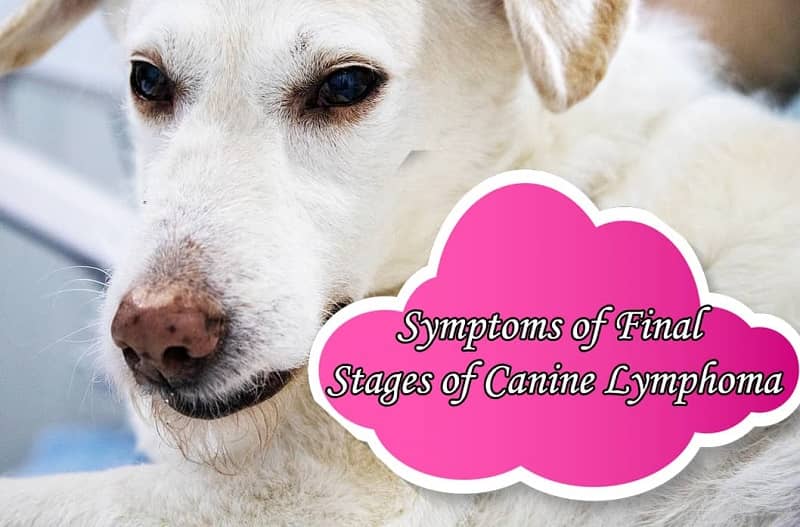We all want what’s best for our dogs. We love showering them with love and affection because we know that’s what they deserve. That’s why we always feed them nutritious food and visit the vet regularly – to make sure that they’re always in their best health.
But sometimes, no matter how healthy our canine friend seems, there are unpredictable circumstances that seem to turn their lives upside-down. One such heartbreaking condition is lymphoma.
While it’s a life-threatening condition, canine lymphoma doesn’t have obvious symptoms at the beginning. It only starts to show once it has already progressed, which can be too late. And that’s truly devastating.
In this article, we’ll talk about the symptoms of final stages of canine lymphoma to help you prepare for what lies ahead.

Lymphoma in Dogs: What is It?
By itself, “lymphoma” is a term that’s often associated with cancer.
So to be more specific, canine lymphoma is a type of cancer that’s present in dogs. This condition is often due to high concentrations of lymphocytes in the dog’s organs, which then causes the immune system to go on overdrive. As a result, these organs suffer from damage, and that could be lethal for your pet.
There are over 30 sub-classifications of canine lymphoma, but the most common ones target the lymph nodes, bone marrow, and spleen. Regardless of where the type of canine lymphoma, symptoms are quite the same – especially once it reaches the final stages. And we’re here to help you identify these symptoms.
What Causes Lymphoma in Dogs?
While experts agree that lymphoma is caused by lymphocytes, the specific reasons why it has gone on overdrive are still unknown. We can only hope that the cause becomes identifiable in the future, so we can finally detect it early on and treat it more effectively.
Symptoms of Final Stages of Canine Lymphoma
Now that you have a deeper understanding of what lymphoma is, we can now start discussing the apparent symptoms of final stages of canine lymphoma.
Loss of Appetite
We can all agree that dogs love to eat. We’re all too familiar with the famous puppy-dog eyes that guilt us into feeding them – even when they just had their meals.
So when our beloved canines suddenly lose appetite, it’s always a cause for concern. This is especially true if he has not touched his food at all.
At times, dogs tend to eat fewer than usual. This is normal if you decide to change his diet. But if you haven’t made changes to his regular meal preparations, then it’s best to take him to the vet immediately. Even if the cause is not lymphoma, it would be a big relief to have it identified and treated as soon as possible.
Nausea
Another notable symptom of stage 5 canine lymphoma is nausea. Like us, dogs don’t gag and vomit at random. It usually happens when we don’t feel good, which is the same for them.
In most cases, gagging and vomiting mean that their system is trying to get rid of something they ate. But in the case of lymphoma, it can be because of swollen organs – making it hard for him to eat anything at all. And that’s truly a cause for concern.
Sudden Weight Loss
Because of the sudden loss of appetite and nausea, your dog can suffer from sudden and extreme weight loss. Regardless of the condition, this is a symptom that should alert you to take him to the vet as soon as possible.
Bear in mind that even if you put your dog on a diet, the weight loss is always gradual. So if your canine friend loses a lot of weight in such a short period, that’s a huge red flag.
Lumps
Perhaps one of the biggest tell-tale signs of lymphoma is the development of lumps. Lumps can develop in different areas of his body – it can be around his armpit, his back, or his neck, to name a few.
These lumps often appear roundish and are quite hard when you touch them. If you find a similar bump on your dog’s body, it’s best to make a trip to the vet immediately.
But, you must distinguish lumps from the more common fat deposits. The latter isn’t always a cause for concern.
Fever
Just like humans, dogs also get fever when they’re not feeling well. But, the tricky part is identifying when a dog has a fever. Because of their naturally warm body temperature, it’s hard for us to identify a fever in dogs.
Nevertheless, you can always ask veterinary experts how it’s done, so you can monitor his temperature at home. And if you do notice a sudden spike in his temperature, check whether he shows any other symptoms of stage 5 lymphoma. If he does, then you shouldn’t take that lightly.
Lethargy
Another common symptom that dogs have when suffering from any disease is lethargy and loss of energy. While this can be attributed to their loss of appetite, it can also be because of their inner discomfort.
When a dog is not feeling well, he won’t be his normal and active self. This is quite easy to pick up on since dogs are very active by nature. Thus, this symptom should instantly put you on high alert – especially when it’s coupled with other symptoms found here.
Final Thoughts
Let’s face it – lymphoma is one of the toughest conditions to diagnose. Because it can potentially attack any organ on your fur baby’s body, it’s hard to run just one test and immediately get results. That’s why, more often than not, we only know about it once it’s already at a progressive stage.
By being familiar with the symptoms of final stages of canine lymphoma, we can help identify whether a dog is suffering from this disease. This will allow him to undergo the necessary treatment to try and restore him to health.
Admittedly, not all lymphoma treatments are successful. But as long as you did what you know is right and took him to the vet as soon as these symptoms start to show, you already did your best as a fur parent. So, don’t put too much blame on yourself for something as inevitable as canine lymphoma.
Related Article:
What is the Best Home Remedy for Dog Mange: Important Tips Every Dog Owner Should Know
Canine Congestive Heart Failure Stages of Dying: Everything You Need to Know
